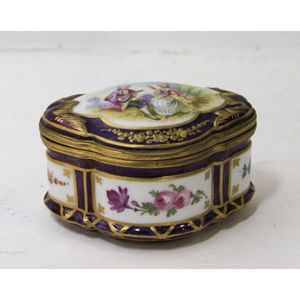Han Dynasty Pottery Tripod Vessel with Cover
A Chinese archaic pottery tripod vesse('Lian') and cover, Han Dynasty (206 BCE-220 ACE), With Daodie 'handles' covered with a dark green lead glaze and supported on three bear-form feet, the cover well moulded with three stylized bands bands around a central flower, very good iridescent glaze, 18.5 cm diameter, 19 cm high. Provenance: Ray and Vicki Tregaskis Oriental Ceramics & Works of Art
You must be a subscriber, and be logged in to view price and dealer details.
Subscribe Now to view actual auction price for this item
When you subscribe, you have the option of setting the currency in which to display prices to $Au, $US, $NZ or Stg.
This item has been sold, and the description, image and price are for reference purposes only.
- Lead Glaze - Lead glaze, also known as lead glaze or leaded glaze, is a type of glaze that contains lead oxide as one of its primary components. It was commonly used in the decoration of Chinese and Western ceramics from ancient times until the mid-20th century.
In Chinese ceramics, lead glazes were used as early as the Tang Dynasty (618-907 AD). The use of lead glazes became more widespread during the Song Dynasty (960-1279 AD), when potters developed the technique of firing ceramics at a high temperature to create a translucent, glass-like surface. This type of glaze, known as "celadon," was often used to decorate delicate porcelain vessels.
In the Western world, lead glazes were also commonly used to decorate ceramics. For example, during the Renaissance, lead glazes were often used to create brightly coloured majolica ware, which was popular in Italy and Spain. Lead glazes were also used in the production of English creamware and pearlware during the 18th and 19th centuries.
While lead glazes were prized for their beauty and durability, they also posed a health risk to potters and consumers, as lead is a toxic substance. Today, the use of lead glazes in ceramics is highly regulated or banned in many countries, and modern ceramic artists have developed alternative glazing techniques that are safer and more environmentally friendly.
This item has been included into following indexes:
Visually similar items

A Peranakan Straits Chinese famille-rose jar with cover, 19th century 17 cm high
Sold by
in
for
You can display prices in $Au, $US, $NZ or Stg.

A Chinese blue and white lidded jar, height 32 cm
Sold by
in
for
You can display prices in $Au, $US, $NZ or Stg.

A Chinese porcelain lidded jar with Shi Shi knop with a continuous Sweet Pea design. Height 17 cm. Diameter 20 cm
Sold by
in
for
You can display prices in $Au, $US, $NZ or Stg.

A French porcelain patch box decorated with hand painted musical figures. 4.5 cm high.
Sold by
in
for
You can display prices in $Au, $US, $NZ or Stg.
